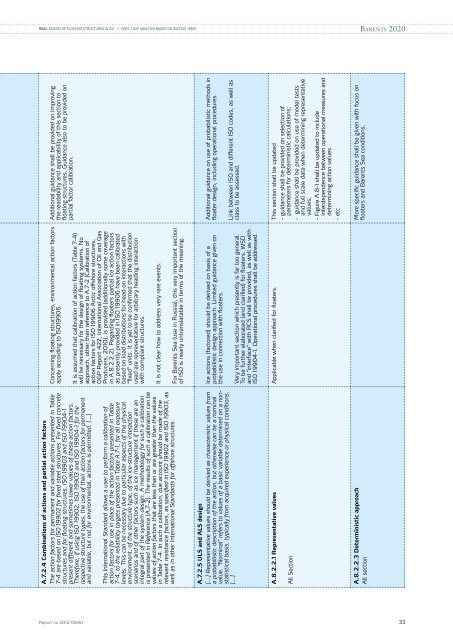phase 4 report - DNV
phase 4 report - DNV
phase 4 report - DNV
Create successful ePaper yourself
Turn your PDF publications into a flip-book with our unique Google optimized e-Paper software.
RN02: DESIGN OF FLOATING STRUCTURES IN ICE // PART 2 GAP Analysis based on ISO/FDIS 19906Barents 2020A.7.2.4 Combinations of actions and partial action factorsThe action factors for permanent and variable actions presented in Table7-4 are based on ISO 19902 for fixed steel structures. For fixed concretestructures and for floating structures, ISO 19903 and ISO 19904-1present different and sometimes lower values of these action factors.Therefore, if using ISO 19902, ISO 19903 and ISO 19904-1 for therespective structure types, the use of their action factors for permanentand variable, but not for environmental, actions is permitted. […]This International Standard allows a user to perform a calibration ofaction factors for use in place of the action factors presented in Table7-4, to the reliability targets presented in Table A.7-1, for all exposurelevels. This can be necessary due to particular aspects of the physicalenvironment, of the structure type, of the ice-structure interactionscenarios and of other factors such as ice management if these are anintegral part of the system design. A methodology for such a calibrationis presented in Reference [A.7-2]. The results of such a calibration can bevalues of action factors that are less than or are greater than the valuesin Table 7-4. In such a calibration, due account should be made of therelevant resistance factors, as specified in ISO 19902 and ISO 19903, aswell as in other International Standards for offshore structures.A.7.2.5 ULS and ALS design[…] Representative values should be derived as characteristic values froma probabilistic description of the action, but otherwise can be a nominalvalue. “Nominal” refers to values of a basic variable determined on a nonstatisticalbasis, typically from acquired experience or physical conditions.[…]A.8.2.2.1 Representative valuesAll SectionA.8.2.2.3 Deterministic approachAll sectionConcerning floating structures, environmental action factorsapply according to ISO19906.It is assumed that calibration of action factors (Table 7-4)will be necessary for the design of floating systems. Noapproach, other than reference to A.7-2 (Calibration ofaction factors for ISO 19906 Arctic offshore structures,OGP Report 422, International Association of Oil and GasProducers, 2010), is provided (additionally some coveragein A.8.2.2.2). Regarding floaters partial ice action factorsas presently provided in ISO 19906 have been calibratedbased on load distributions for head-on interactions with“fixed” units. It is yet to be confirmed that the distributionused are representative for arbitrary heading interactionwith compliant structures.Additional guidance shall be provided on improvingthe readability and applicability of this section tofloating structures. Guidance also to be provided onpartial factor calibration.It is not clear how to address very rare events.For Barents Sea (use in Russia), this very important sectionof ISO is nearly untranslatable in terms of the meaning.Ice actions (factored) should be derived on basis of aprobabilistic design approach. Limited guidance given onthe use in connection with floaters.Additional guidance on use of probabilistic methods infloater design, including operational procedures.Very important section which presently is far too general.To be further elaborated (and clarified) for floaters. WSDand “interface” with RCS shall be provided, as well as withISO 19904-1. Operational procedures shall be addressed.Link between ISO and different ISO codes, as well asclass to be assessed.Applicable when clarified for floaters. This section shall be updated- guidance shall be provided on selection ofparameters for deterministic calculations;- guidance shall be provided on use of model testsand full scale data when determining representativevalues;- Figure A.8-1 shall be updated to includeinterdependence between operational measures anddetermining action values- etcMore specific guidance shall be given with focus onfloaters and Barents Sea conditions.Report no 2012-0690 33






![Risk Based Pipeline Integrity Management [Compatibility Mode] - DNV](https://img.yumpu.com/50424229/1/190x146/risk-based-pipeline-integrity-management-compatibility-mode-dnv.jpg?quality=85)









